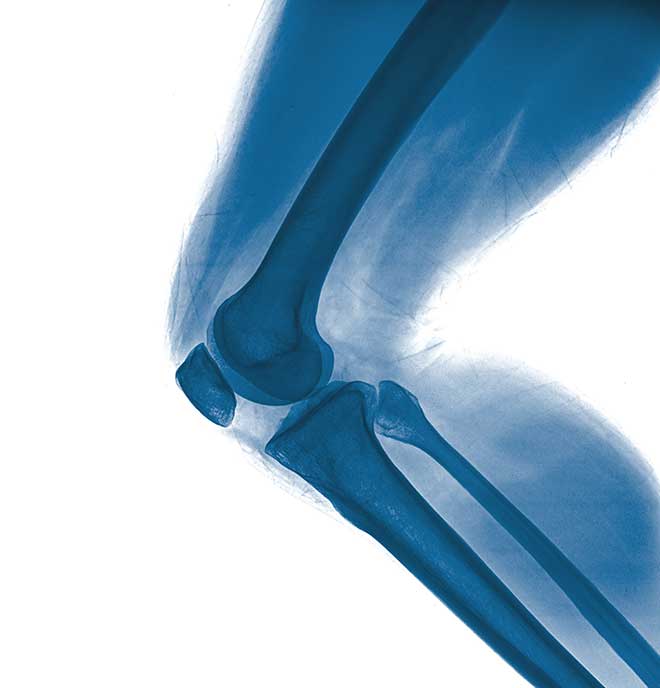When it comes to our health, we seem to take it for granted until something goes wrong. Then, nothing seems right. Headaches, arthritis pain, itching or any other chronic annoyance can take over your life if you let it. That’s why it’s so important to find relief asap.
restless leg syndrome
A spooky limb with a mind and life of its own: the stuff of horror films? Yes, but it’s also a condition of everyday life for many. Did you know that one in 10 of us live with restless leg syndrome—the sensation of an uncontrollable arm or leg?
is it real?
“Restless leg syndrome is a neurological sleep disorder that causes people to have uncomfortable sensations in their extremities, typically occurring in the evening,” explains Dr. Ramon Malhotra, co-director of SLUCare Sleep Disorders Center. People describe it as a prickly or numb sensation or sometimes an urge to move their extremities, he says. “They can have a difficult time falling and staying asleep, and can flip and flop, bothering their bed partner.”
The sleep disturbance can be quite significant, adds Dr. Leonard Weinstock of Midwest Small Intestinal Bacterial Overgrowth Center, which reports a link between the gastrointestinal tract and RLS. “It is associated with hypertension and a higher incidence of strokes. It can be difficult to travel on airplanes or go on long car rides.”
About a third to half of patients have a family history of RLS, so there could be a genetic component, says Malhotra. “We think one key player is dopamine, a substance in the brain that communicates between nerve cells. The thought is that a deficiency of dopamine causes people to have an urge to move their arms and legs.”
what to do
If someone has even borderline low levels of iron, sometimes giving supplemental iron will help treat this condition, Malhotra notes. The possible link to iron deficiency is illustrated by the gender imbalance in the incidence of RLS, he explains. “Women have it more often than men by about a two-to-one ratio. We don’t have a great explanation, but obviously menstruating women are more likely to be irondeficient than men.”
The second medicinal approach is administration of dopamine itself, orally or with skin patches. “The medications tend to be quite effective—about three-quarters of patients will respond to them,” Malhotra says. Possible side effects include sleepiness, he says, and if the dopamine enters the wrong part of the brain, people can get nauseous.
Non-pharmacological approaches include warm baths, soothing massages, stretching and exercising before bed. “These all can be helpful,” Malhotra says. “People also are looking at devices that can be placed over the legs before bedtime to heat and massage them for 10 or 15 minutes.”
gut reaction
Links recently have been discovered between stomach inflammation and other diseases such as restless leg syndrome, Weinstock reports. “One theory is that small intestinal bacterial overgrowth can inflame the small intestinal lining. Then, inflammatory proteins are secreted into the body’s circulation,” he says. “There also is potential that immune cells produce antibodies that attack the nervous system and that it is caused by small intestinal bacterial overgrowth.”
Weinstock also points to a relatively new discovery of decreased endorphins in the brains of people who have restless leg syndrome. He has published medical journal papers about his approach to treating RLS through the gut. “If there is bacterial overgrowth, I treat that,” he says. “On top of that, we use a compound called low-dose naltrexone, or LDN, which blocks endorphin receptors for a short period of time and tricks the body into a rebound production of endorphins.”
His research found that this approach moderately or markedly improved RLS symptoms in 57 percent of patients.
arthritis
The odds of suffering from osteoarthritis at some point in life are exactly the same as the likelihood of the sun rising tomorrow. That’s right: Everyone will get some form of the degenerative ailment if they live long enough.
ailment of aging
Arthritis is a term that covers more than 100 conditions that cause pain or disease in the body’s joints. For some, it is caused by inflammation, infections or metabolic disease (which is responsible for gout). But the most common form is osteoarthritis, a non-inflammatory process that results from the wear-and-tear process, according to Dr. Dany Thekkemuriyil, a rheumatologist in the SSM Health Medical Group. “As the joint undergoes more and more use, the cartilage wears off, the joint space narrows, and the bones in the joint come closer together. That is most common in the knees because they are weight-bearing.”
More than half of Americans being treated for arthritis—about 27 million—have been diagnosed with osteoarthritis, according to the Arthritis Foundation. Genetics predispose some people, Thekkemuriyil says. “Some factors are the mechanical stresses your joints encounter, maybe due to your line of work. Athletes, especially football players, get arthritis faster because they have had a lot of injury to their joints.”
what happened?
Your personal relationship with osteoarthritis began long ago. Maybe it was the crunching sound you heard from your back while playing on the trampoline at age 8. Or that awkward, knee-twisting fall on the basketball court at 17. Most likely, it was that ‘yard-sale’ tumble down the ski slopes at 28 that left your entire body aching for weeks.
And you have been getting better acquainted with osteoarthritis ever since, whether you realized it or not. “In the beginning stages, people may start to notice a little bit of joint discomfort or aching, most of the time in a joint that has been injured,” Thekkemuriyil says. “Usually we see some symptoms after the age of 30 or 40. By your fifth and sixth decade, it will be worse.”
Osteoarthritis has its favorite places, like “joints that are used more and are weight-bearing—knees, hips and spine. The hands are the least commonly affected or will be the last joints to be affected,” he says. “You don’t bear much weight with your hands, but people who work with their hands a lot get osteoarthritis in them.”
now what?
The severity is what matters, Thekkemuriyil notes. “In the early stages, we do symptomatic control with antiinflammatory medicine or analgesics like Tylenol for pain,” he says. “Exercise and physical therapy also are very good to strengthen the muscles around the joint and keep the alignment of the joint right.”
As the wear-and-tear progresses, the pain becomes more constant, he says, which is when patients might turn to corticosteroid injections that can give more relief. “As the joint wears out, the bones’ outer surfaces get rough and lose their normal architecture,” Thekkemuriyil says. “Bits of bone called osteophytes project outside of the joints. That is what you see on the knuckles of some people as they get older.”
As the condition worsens, physicians can give injections of a viscous liquid that replaces cartilage to provide some padding and lubrication between the bones. “That has been shown to have some benefit,” Thekkemuriyil says. The liquid goes by the product names Synvisc and Hyalgan and is based on hyaluronic acid, a natural component of joint fluid.
For many, the time will come to take the painful joint into the shop for repairs. “Surgery is considered when we can see on X-rays that there is no cartilage left and the joint really is bone-on-bone,” Thekkemuriyil says. “The main indication is when the pain is affecting activities.”
bad knees
It will happen to many of us. Pain, limping and finally, the realization that we need meniscus surgery or a new knee. These are two very different procedures, but with a little luck, they will yield decades of better mobility.
what’s a meniscus?
This is cartilage that usually cushions the knee dutifully and anonymously. It bears weight and twisting stresses, making meniscus tears one of the most common knee injuries. “The meniscus is the shock absorber of the knee,” says Dr. Joshua P. Naudad of Agility Orthopaedics. “People stay active longer in life and are more aggressive with activity. We see patients who have worn down their knees through repetitive activities, although some meniscus injuries are associated with arthritis.”
The knee is probably our body’s largest weight-bearing joint, and there are a lot of stresses across it, even more than in the hip or ankle, says Dr. Robert A. Sciortino of Jones and Sciortino Orthopedics in Chesterfield. Sciortino agrees that meniscus injury is a curse of aging. “As we age, our meniscus loses some of its elasticity and becomes more brittle,” he explains. “Something that may not normally cause an injury can start a little tear because the meniscus is not as resilient with age.”
start slow
If the pain is minor, it may be addressed with minimal treatment, Naudad says. “Corticosteroid injections or physical therapy are options for initial management. But if there is an acute tear or the patient experiences a lot of pain, then the meniscus should be fixed surgically.”
Meniscus tears likely will not heal themselves, Sciortino points out. “The meniscus doesn’t have a very good blood supply, so once it starts tearing, it doesn’t have the ability to heal,” he says. “People can have symptoms for months and years because it stays torn.”
A curious presentation is commonly known as ‘water on the knee,’ which is caused by swelling due to arthritis, a meniscus tear, a ligament strain or a sprain, Naudad explains. “Usually it requires medical investigation by a physician or orthopedic surgeon to determine why.”
Many patients initially seek other treatments to alleviate pain—nutritional supplements, acupuncture or chiropractic. Curcumin, a substance in the turmeric spice family, is thought to have anti-inflammatory properties. “I don’t know if there are scientific studies showing it to be beneficial, but there are some anecdotal reports,” Sciortino says. “Similarly with glucosamine and chondroitin—but studies are conflicting. It is OK to try acupuncture or chiropractic.”
A new treatment is platelet rich plasma (PRP) therapy. “We take the patient’s blood and spin it down in a centrifuge to get the growth factors that promote healing,” Naudad says. “It is injected into the patient’s knee. I have had success with that.” It has yet to be determined how many knee surgeries and replacements may be foregone through PRP therapy, he says. “It is too early to tell.”
call in replacements
When other options have been exhausted, it may be time to order parts for a new knee. “Replacements are done for patients who have end-stage arthritis of the knee,” Naudad says.
The decision to do this surgery—a major procedure—should be up to the patient, Sciortino says. “Everyone is different. I have seen people with terrible-looking arthritis on X-rays who say the pain is not too bad,” he says. “And I have seen people who have a moderate amount of arthritis but are incapacitated.”
As for prevention, exercise “is good for prevention,” says Sciortino. Keeping your knees strong and flexible is very helpful in preventing injuries from sudden starts and stops. In fact, activity is the orthopedic surgeon’s goal, Naudad explains. “I became an orthopedic surgeon so I could get people back to the activities they love.”








